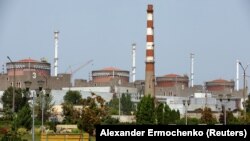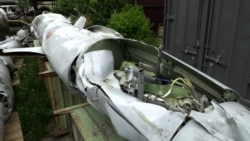The fate of the massive nuclear power plant in the crosshairs of Europe's largest war in decades has made for worrisome headlines since Russia launched its large-scale invasion of Ukraine nearly 18 months ago. As fighting intensifies not far from the plant, fears of a disaster have not abated.
On August 10, the main power line delivering electricity to the Zaporizhzhya nuclear power plant was disconnected twice, forcing it to rely on its last remaining off-site power line.
The main line was reconnected by evening. In the meantime, though, Ukraine's energy minister raised the prospect of a meltdown.
Is Russia's invasion of Ukraine about to cause a nuclear catastrophe?
Steven Nesbit, a nuclear power industry veteran who was president of the American Nuclear Society in 2021-22, told RFE/RL that the Zaporizhzhya plant has been in a precarious position since the start of Russia's full-scale invasion. But the failure of the off-site power line did not make his assessment of the situation any more dire than it had been.
"I don't see anything really new right now that should have people extremely concerned relative to the already undesirable situation," he said, adding that the plant's offsite power sources have been interrupted before due to the war.
"I would not be surprised if it happens again, but simply losing one of the off-site power sources for a period of time is not a reason for undue concern," said Nesbit, who now runs his own nuclear consulting company.
Enerhoatom, Ukraine's state-owned nuclear power generating company, was the first to raise the alarm on August 10, saying that the plant was "on the verge of another blackout" after the main high-voltage line was disconnected, forcing operators to use the 330-kilovolt backup line.
In a statement the same day, the International Atomic Energy Agency (IAEA), said that the main 750-kilovolt line had disconnected twice since the early morning and remained disconnected as of the evening. The plant had to "rely on its only remaining off-site power line, the 330 kV backup line, to supply the electricity that is required, for example, to perform safety functions such as pumping cooling water for the plant."
Energy Minister Herman Halushchenko said the plant was "one step away from a blackout -- that is, the complete loss of external power," and that this could lead to a "major catastrophe."
The plant would resort to diesel generators if all external power was lost, but if the generators were damaged by a Russian attack, he said, "the cooling of the plant would stop and the irreversible process of heating and melting of nuclear fuel" would begin.
"I think that's a little alarmist," Nesbit said in a phone interview on August 11.
The same day, Enerhoatom said on Telegram that the main power line had been reconnected the previous evening after being knocked out by Russian fire.
The diesel generators are well protected and have enough fuel to provide power to keep the cooling system going for an extended period of time while external sources are being restored, Nesbit said.
"The six units can share power among them. It's a flexible and safe system," he said.
The Zaporizhzhya plant has lost all external power at least twice in the past year.
WATCH: RFE/RL has found documentary evidence that Russia is attacking Ukraine with cruise missiles that Kyiv handed over to Moscow in the 1990s.
Last November, the diesel generators kicked in when the plant lost its connection to both the main and reserve off-site power lines, in what IAEA Director-General Rafael Grossi called "an extremely concerning development that again demonstrates the plant's fragile and vulnerable situation."
At the time, Enerhoatom said there was enough fuel to run the emergency generators for about 15 days.
Russia seized the Zaporizhzhya nuclear power plant, which supplied about a fifth of Ukraine's power needs, shortly after the launch of its full-scale invasion on February 24, 2022.
The plant and the surrounding area are controlled by Russia, but it is being run by its Ukrainian engineers. In September 2022, Ukraine shut the station down to minimize risk of a catastrophe.
Five of the six reactors are in what is known as cold shutdown mode while one unit is being maintained at an elevated temperature -- hot shutdown mode -- to provide auxiliary steam and heating, the American Nuclear Society, which is monitoring information about the plant, said in July.
As a result, the level of heat production has been low and on-site equipment can provide enough of the water needed for cooling, the society, an international organization of engineers and scientists, said in a statement.
It called the threat of a large-scale release of radioactive material "speculative" but said that assessment does "not constitute an 'all clear' for safety risks at the plant site."
Nesbit said it is of crucial importance that the reactors at the Zaporizhzhya plant have not been generating power for months, allowing the heating level associated with the reactor fuel to fall. The shutdown cuts by many orders of magnitude the amount of radioactivity that could potentially be released in the event of a major incident involving the reactors.
Still, tension is high.
The plant is located in the Zaporizhzhya region in southeastern Ukraine, where fighting is intense amid a counteroffensive that Kyiv launched in early June, seeking to push Russian forces back from territory they have taken and eventually expel them from the country altogether.
Zaporizhzhya is one of four regions of Ukraine that Moscow claimed last year had become part of Russia but does not hold in their entirety. The plant stands on the south bank of a wide stretch of the Dnieper River that was largely drained by the breach of the Kakhovka dam downstream, while Ukraine controls the north bank.
Ukraine and Russia have accused each other of planning to sabotage the plant, warning of the possibility of a nuclear disaster that could threaten millions of people and poison the environment.
Ukraine recently claimed that Russia mined the roofs of the Zaporizhzhya reactors. Last week, the IAEA said its experts found no mines on the two reactors it was allowed to inspect. IAEA has yet to receive Russian permission to visit the other reactors.
It did find antipersonnel mines on the "periphery" of the plant's grounds, but such weapons are small and designed to pierce the human body, not one-meter-thick, steel-reinforced, concrete walls. Even a few mines on the roof would not be enough to cause a radioactive release, experts say.
Since it launched the full-scale invasion, Russia has repeatedly accused Ukraine of plotting set off a dirty bomb or cause a release of radioactivity and then blame it on Moscow. Russia asserted last week that Ukraine tried to attack the Zaporizhzhya plant with a drone.
Kyiv dismissed the claim as nonsense, and experts say it makes no sense for Ukraine to threaten a catastrophe on its own land.
Construction of the Zaporizhzhya plant began in 1980 as tensions between the Soviet Union and the West ratcheted up and concerns that the Cold War could turn hot increased.
The Zaporizhzhya plant "is designed to withstand a lot of challenges, both internal and external," Nesbit said. "Nuclear power plants were not designed to necessarily be impervious to wartime, but the characteristics that they do have -- the thick containment buildings around the reactor vessels -- do offer substantial protection in the event of hostilities."
He said, for example, that the hazard posed by a single, unmanned flying vehicle – a drone -- is pretty low.
Nesbit also said that he does not believe either side is motivated to cause damage to the plant but that war is unpredictable.
"The concern that we all have is that because it's wartime, you can't always control what's going to happen," he said.














